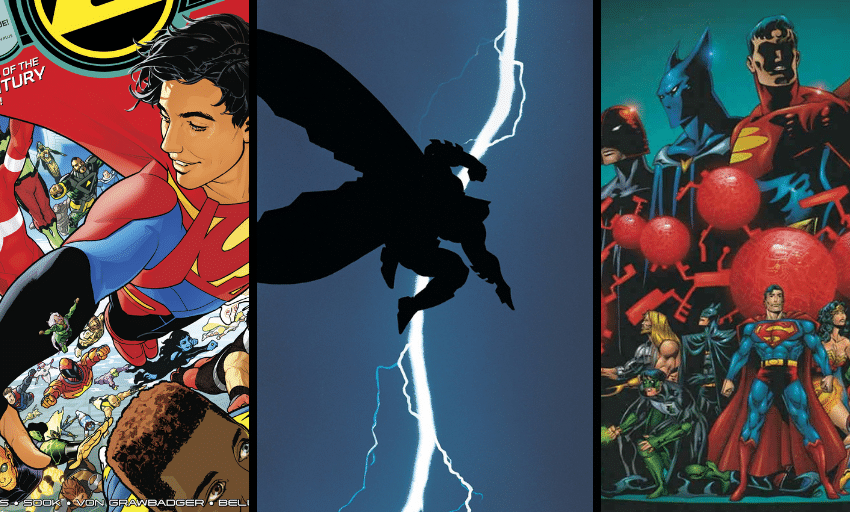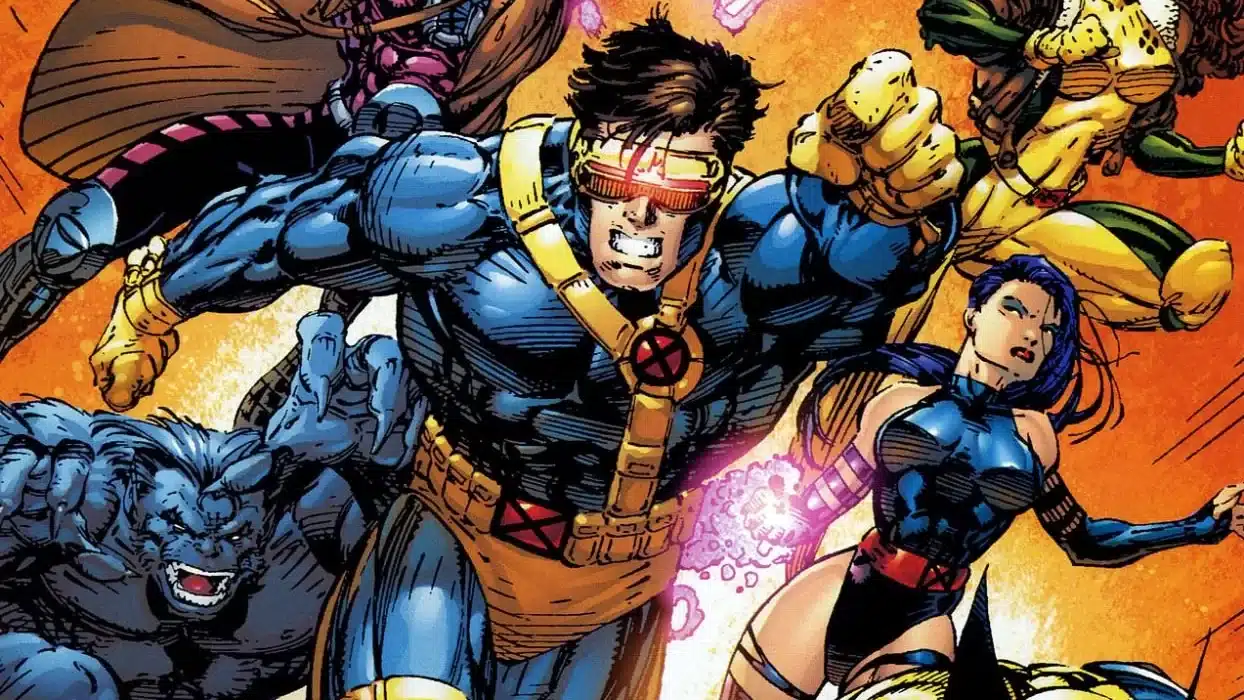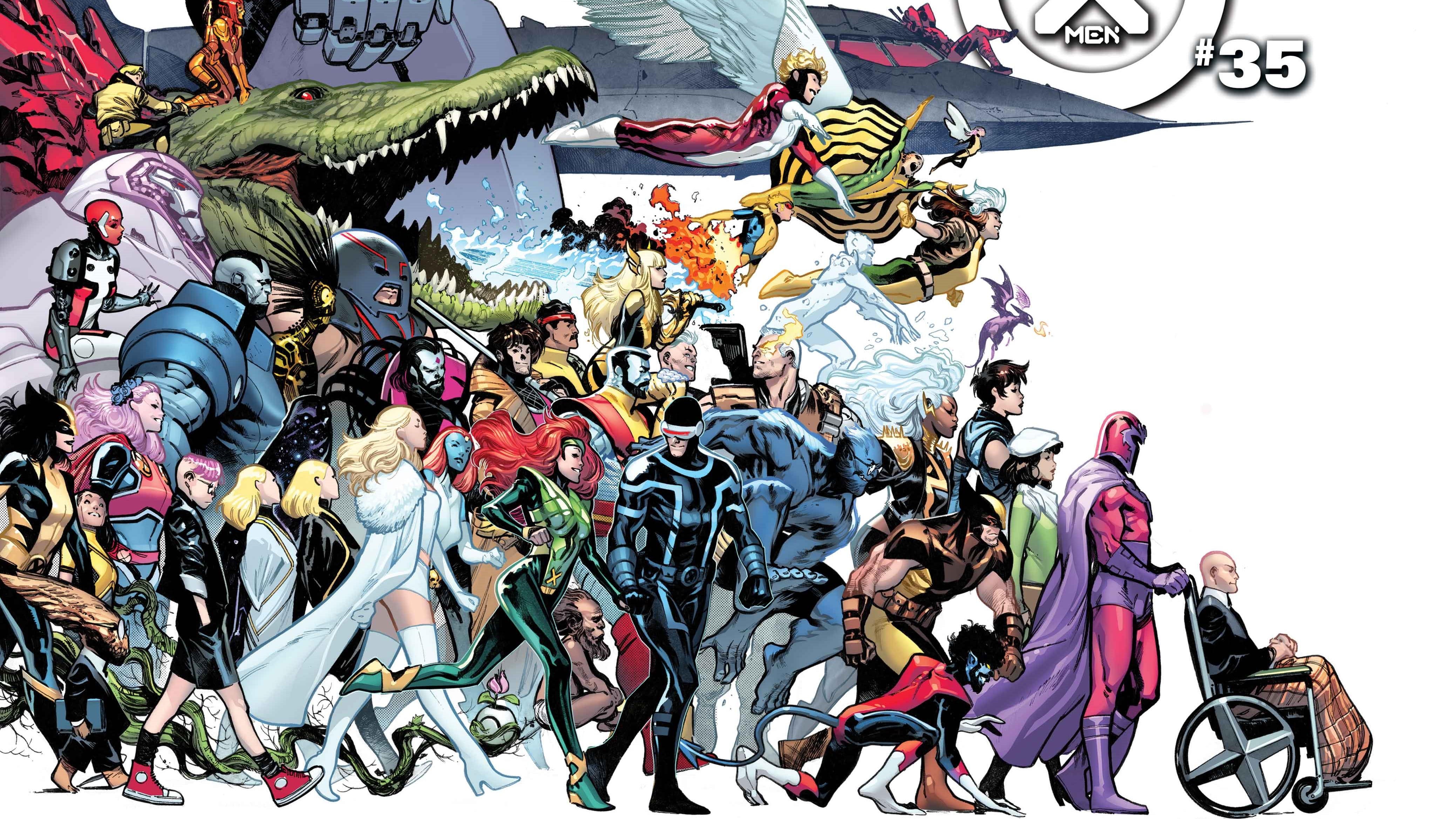Welcome to the world of tomorrow! Superhero comics have regularly featured time travel, possible futures and glimpses of tomorrow for much of their history. Some are utopias, some are dystopias and most are somewhere in between.
DC is in the midst of a two-month event, “Future State,” that gives readers a glimpse into the future of its heroes, sometimes as near as a few years, sometimes as far away as the end of time.
But this is far from the first time DC has given readers a glimpse of the future. This week, Bonus Reading looks at three stories set in DC’s possible futures, from the sublime to the … not so much.
Legion of Super-Heroes

In the 30th century, the galaxy still needs heroes. While the United Planets help keep the peace in many of the inhabited star systems, there are threats that are beyond the Science Police. And when those threats rear their heads, the Legion of Super-Heroes goes into action.
Created in 1958 by Otto Binder and Al Plastino, the Legion is a team of teen superheroes from the far future who first appeared in Superboy stories. They recruited the Boy of Steel, who would travel into the future and join them on all manner of Silver Age adventures. Starting out with three members (Cosmic Boy, Lightning Lad and Saturn Girl), the Legion soon ballooned to nearly 30 members, with characters sometimes shuffled off to a minor league team, the Legion of Substitute Heroes, just to keep the number of members at a level that was, well, still often too many.
The Legion had, and still has to this day, a diehard fanbase. While the characters age more slowly than people in the real world do, they aged more rapidly than many comic book characters do, and with this came real change. The Legion had one of the first, and most long-lasting, deaths in comics, with the death of Ferro Lad. Members Bouncing Boy & Duo Damsel and Lightning Lad & Saturn Girl got married and stepped away from the team. Some of DC’s first BIPOC and queer characters were established in the Legion, even if the latter was often subtextual.
Because of this, Legion continuity was pretty tangled for the uninitiated. And it only got more so when Crisis on Infinite Earths happened. The Legion was supposed to be inspired by Superboy, but when the Crisis erased Superboy, things got … tricky. All manner of time-travel shenanigans were used to try to explain all of this without a hard reboot like much of the DCU got after that event, and eventually, during 1994’s Zero Hour, the Legion finally got a reboot. And then, shortly before the events of Infinite Crisis, the Legion got ANOTHER reboot. And then, shortly before Final Crisis, a slightly streamlined version of the original Legion was reintroduced, since the new history had Superboy again. And recently, another reboot occurred tying in with the founding of the United Planets in the present, and making Jon Kent, the son of Superman and Lois Lane, the inspiration for the team. And that’s not counting other eras and tidal shifts in the team’s history.
So, yeah, putting that all out there, you can see why the Legion is often viewed as DC’s answer to the X-Men: young heroes who tend to be compartmentalized in their own part of the universe with deeply tangled continuity. But while it is tricky to find a solid entry point, it’s well worth it. Because as dark as some of their adventures can get, at the heart of the Legion is a sense of hope. The fact that humanity is still out there, fighting to make a better world 1,000 years in the future, is hopeful, and the Legion, as a team of young people, are a hope for the future. The early stories are pure Silver Age goofiness, but as you enter the late 1960s into the 1970s, when Jim Shooter and then Paul Levitz took over, the book becomes a lot more intricate and interesting. And if you’re a fan of Dan Abnett and Andy Lanning’s run on Guardians of the Galaxy, you should check out their late ’90s/early ’00s Legion run: It is their first cosmic epic, and the early Olivier Coipel is phenomenal.
I recommend The Great Darkness Saga (almost unanimously known as the greatest Legion story, in which the Legion fights Darkseid for the first time) and Legion Lost (the 12-issue Abnett/Lanning/Coipel maxi-series).
The Dark Knight Returns

Nothing like going into one of comics’ most famous dystopias right after a shiny far future. Frank Miller, Klaus Janson and Lynn Varley’s The Dark Knight Returns is one of the, if not the, most influential Batman stories ever written. Set in a future Gotham where Bruce Wayne retired and the city has slowly descended into even worse chaos than it was before Batman, we see an aged Wayne come out of retirement to deal with gangs, some of his former foes and a civil government that has become fascistic. In the end, Wayne seemingly gives up the Batman identity to lead a new generation of young people to fight crime.
That synopsis is simplistic, and probably unnecessary for one of the most read comic books of the past 35 years. The story has some aspects of a sci-fi noir, including grizzled first-person narration from Batman throughout much of the book and a hero who is constantly beaten down but gets back up. But, despite the darkness, there is more hope in DKR than in a noir. New Robin Carrie Kelly is a ray of sunshine, helping Batman find his way back to heroism and a better place.
Looking back, DKR is very much a piece if its time. The nuclear war themes that are part of the Superman plot are very much of the mid-’80s, and the use of Ronald Reagan as president is timely satire. The floating TV heads, while still timely in our 24-hour, deeply partisan news cycle, would not have happened before the mid-’80s, and the talk show sequences haven’t aged particularly well.
I have a complicated relationship with this book. I appreciate the strength of this comic, the design of it, the groundbreaking nature of the story, and the story is mostly good. But it’s hard to separate a few things out from it now. One of those things is the pit of despair it sunk Batman stories into for the next … 34 years and counting. So many Batman stories are a response to, or indictment of, this story. There’s also the issues with Frank Miller as a human being outside the book, and his rampant xenophobia. And while it’s best to judge a book on its own merits without looking at what directly follows it, neither of the sequels, The Dark Knight Strikes Again or Dark Knight III: The Master Race, do the legacy of this series any favors.
Still, if you haven’t read The Dark Knight Returns, it is worth it for a solid dystopian Batman story and a look at how superhero comics evolved in the ’80s.
DC One Million

There are crossover events, like Crisis on Infinite Earths or the Jonathan Hickman Secret Wars, that reshape a superhero universe. Many readers expect a crossover to be that, a story with universe-shaking ramifications. But there are a few examples of crossovers on a smaller scale, ones that are there to simply tell a fun, interesting story. And the best example I can think of when it comes to a crossover that just is there to tell a big story without changing the status quo is DC One Million.
The main story, written by Grant Morrison; drawn by Val Semeiks; inked by Prentis Rollins, Jeff Albrecht and Del Barras; and colored by Heroic Age, is pretty straightforward. The Justice Legion A of the 853rd century, when DC Comics would theoretically hit issue #1,000,000 if published continually, comes back in time to bring the original Justice League to their time to celebrate the return of the original Superman, who has spent millennia in the heart of the sun and is now returning to humanity. But a plan has been hatched by the immortal Vandal Savage and Solaris, the Tyrant Sun, an AI that inhabits an artificial sun, to destroy Superman and his allies in the past and the present. There’s all sorts of timey-wimey stuff, but in the end, the Justice League and Justice Legion defeat their foes, and Superman returns in the future and gets an ending that can only be described as a happily ever after.
There are a couple of things that make DC One Million stand out. One is that this is a Grant Morrison comic from the late ’90s/early ’00s, where their superhero stuff was still high concept and out there, but hadn’t quite become as surreal as their work would become starting with things like New X-Men and their Batman run. This is very retro Silver Age storytelling, with big stakes that wind up coming to a happy, satisfying conclusion. This is a story about optimism, about a better future, and one where the good guys have an unabashed win at the end. It doesn’t mean the stakes are low. The city of Montevideo is wiped out by an atomic explosion at the beginning, and a techno-organic virus of sorts runs roughshod over humanity for a good part of the series, but it’s a story that ends up with heroes being heroes, and people making the right choice even if they made the wrong one to begin with.
There’s an apocryphal story that Morrison actually plotted all the crossovers, each of which was a special issue numbered #1,000,000 for that month, but even removing that, it’s clear they provided the creative teams of the different books a strong idea of where this series was going, as not only are there none of those weird blips you often see in crossovers when things don’t line up quite right, but many of the crossovers really flesh out the main plot without being essential if you just want to read the main book.
The future of DC One Million has popped up a few times since its inception, most notably in an 80-page giant set in that future, the shortived ongoing series starring the Hourman of the time who came back to the present to better understand humanity, an issue #1,000,000 for Booster Gold’s ’00s ongoing, and some characters in the pages of one of Morrison’s other greatest works, All-Star Superman.
There is an excellent omnibus containing all of DC One Million and its crossovers (except Young Heroes in Love, a creator-owned book set in the DCU that DC no longer has the rights to).
Matt Lazorwitz read his first comic at the age of five. It was Who's Who in the DC Universe #2, featuring characters whose names begin with B, which explains so much about his Batman obsession. He writes about comics he loves, and co-hosts the creator interview podcast WMQ&A with Dan Grote.






